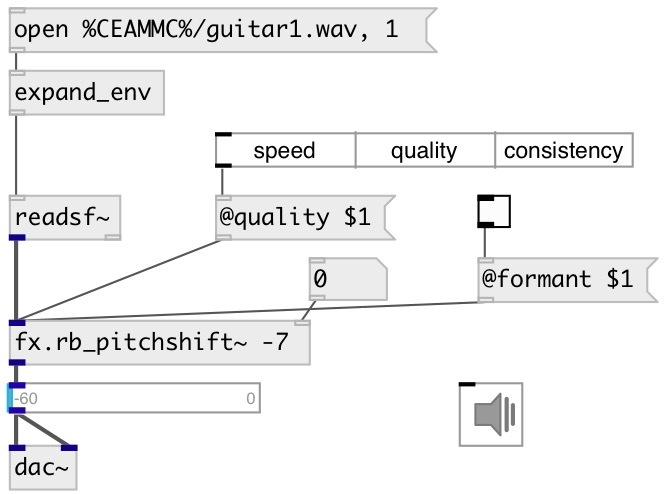PureData CEAMMC web documentation
PureData CEAMMC library web documentation
Distribution download
index :: fx
fx.rb_pitchshift~
pitchshift from the rubberband library
available since version: 0.9.4
arguments:
- TRANSPOSE
transposition in semitones
type: float
units: semitone
properties:
-
@detector Get/set control the type of transient detector used. 'compound' a general-purpose transient detector which is likely to be good for most situations. 'precussive' detect percussive transients. 'piano' use an onset detector with less of a bias toward percussive transients. This may give better results with certain material (e.g. relatively monophonic piano music).
type: symbol
enum: compound, percussive, soft
default: compound -
@formant Get/set control the handling of formant shape (spectral envelope) when pitch-shifting. If 'true' preserve the spectral envelope of the unshifted signal. This permits shifting the note frequency without so substantially affecting the perceived pitch profile of the voice or instrument. 'False' apply no special formant processing. The spectral envelope will be pitch shifted as normal.
type: bool
default: 0 -
@latency (readonly) Get object latency
type: float
units: samp
default: 1024 -
@phase Get/set control the adjustment of component frequency phases from one analysis window to the next during non-transient segments. 'False' adjust the phase in each frequency bin independently from its neighbours. This usually results in a slightly softer, phasier sound. 'True' adjust phases when stretching in such a way as to try to retain the continuity of phase relationships between adjacent frequency bins whose phases are behaving in similar ways
type: bool
default: 1 -
@quality Get/set method used for pitch shifting. 'speed' may sound less clear than 'quality', especially for large pitch shifts. 'quality' method has a CPU cost approximately proportional to the required frequency shift. 'consistency' gives greatest consistency when used to create small variations in pitch around the 1.0-ratio level. Unlike the previous two options, this avoids discontinuities when moving across the 1.0 pitch scale in real-time. It also consumes more CPU than the others in the case where the pitch scale is exactly 1.0.
type: symbol
enum: speed, quality, consistency
default: speed -
@scale Get/set transposition as ratio
type: float
range: 0.25..4
default: 1 -
@smooth Get/set control the use of window-presum FFT and time-domain smoothing. If true result in a softer sound with some audible artifacts around sharp transients, but it may be appropriate for longer stretches of some instruments and can mix well with @window short
type: bool
default: 0 -
@trans Get/set control the component frequency phase-reset mechanism that may be used at transient points to provide clarity and realism to percussion and other significant transient sounds. 'crisp' reset component phases at the peak of each transient (the start of a significant note or percussive event). This usually results in a clear-sounding output, but it is not always consistent, and may cause interruptions in stable sounds present at the same time as transient events. The @detector property can be used to tune this to some extent. 'mixed' reset component phases at the peak of each transient, outside a frequency range typical of musical fundamental frequencies. The results may be more regular for mixed stable and percussive notes than 'crisp', but with a "phasier" sound. The balance may sound very good for certain types of music and fairly bad for others. 'smooth' do not reset component phases at any point. The results will be smoother and more regular but may be less clear than with either of the other @trans settings
type: symbol
enum: crisp, mixed, smooth
default: crisp -
@transpose Get/set transposition in semitones
type: float
units: semitone
range: -24..24
default: 0 -
@window Get/set the window size. 'standard' is expected to produce better results than the other window options in most situations. 'short' may result in crisper sound for audio that depends strongly on its timing qualities. 'long' is likely to result in a smoother sound at the expense of clarity and timing
type: symbol
enum: standard, short, long
default: standard
inlets:
- input signal
type: audio - pitch shift in semitones
type: control
outlets:
- output signal
type: audio
keywords:
Authors: Serge Poltavsky
License: GPL3 or later
